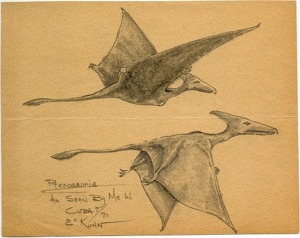Live Pterosaurs Versus Extinct Woodpeckers
Norman Huntington (a pseudonym used by American author Jonathan Whitcomb), a writer on a cryptozoology blog, contends that sightings of apparent pterosaurs in Cuba, in the 1960′s and 1970′s, are not from misidentified woodpeckers. He was replying to another cryptozoology post, by a Dale Drinnon, in which extinct woodpeckers were suggested as an explanation for the “pterodactyl” encounters.
According to Huntington/Whitcomb, eyewitness accounts of featherless flying creatures with head crests and long tails, at Guantanamo Bay, Cuba, are not from the imaginations of persons who had watched too many Flintstones cartoons. He suggests that the most modern insights into pterosaur fossils allow for the possibility that a large long-tailed pterosaur species with a head crest might very well have lived, and might still be living.
That line of thinking comes from details in two sighting reports from the U.S. military installation at Gitmo, Cuba. Patty Carson reported a flying “dinosaur” was there in 1965 and Eskin Kuhn reported two “pterodactyls” were there in 1971. Both eyewitnesses drew sketches, neither of which looked anything like a woodpecker. Both sketches looked like pterosaurs with long head crests and no feathers.
In addition, those two sketches have compared favorably to details in sighting reports from other areas of North America, including in the United States, according to Whitcomb.
Pterosaurs and Woodpeckers in Cuba
There were at least a small number of basal pterosaurs that had head crests, and basal pterosaurs are the ones that had long tails.
“I was looking in the direction of the ocean when I saw an incredible sight. It mesmerized me! I saw two pterosaurs . . . flying together . . . perhaps 100 feet [high], very close in range from where I was standing, so that I had a perfectly clear view of them.”
